Bioturbation enhanced petrophysical properties in the Ordovician carbonate reservoir of the Tahe oilfield, Tarim Basin, NW China
Yong-Bin Niu , Mng-Yuan Chng , Li-Jun Zhang ,*,Jian-Hua Zhong , Shng-Xin Liu , Duan Wi , Zi-Lu Xu ,Pi-Jun Wang
a Key Laboratory of Biogenic Traces and Sedimentary Minerals of Henan Province, Jiaozuo 454003, Henan Province, China
b Collaborative Innovation Center of Coalbed Methane and Shale Gas for Central Plains Economic Region,Henan Polytechnic University, Jiaozuo 454003, Henan Province, China
c School of Geoscience, China University of Petroleum (East China), Qingdao 266580, Shandong Province,China
d Institute of Geomechanics, Chinese Academy of Geological Sciences, Beijing 100081, China
e School of Energy Resource, China University of Geosciences (Beijing), Beijing 100083, China
f Development Affairs of Tarim Oilfield, PetroChina, Korla 841000, Xinjiang Uygur Autonomous Region, China
Abstract Bioturbation plays an important role in enhancing the reservoir capacity of tight reservoirs. This study aims to understand the alteration mechanism and effects of bioturbation on oil and gas reservoirs, to clarify the key control factors and constraints influencing the production of bioturbation. The petrophysical characteristics of bioturbation and host sediments in carbonate rocks, such as mineral composition, pore spaces, porosity and permeability, were studied based on the detailed observation and description of the Ordovician cores from the Tahe oilfield. The effect of bioturbation on petrophysical properties of carbonate rocks were carefully analyzed. The results show: (1) Two types of bioturbation, Thalassinoides-like burrows and Planolites-like burrows, mainly occur in the Ordovician cores of the Tahe oilfield, ranging from the Lower-Middle Ordovician Yingshan Formation to the Middle Ordovician Yijianfang Formation.The burrow-fills are mainly composed of dolomite with subhedral and euhedral crystals. The host sediments mainly consist of micrite. (2) The pores in the host sediments are poorly developed and are incapable of forming effective reservoir spaces. However, well-developed intercrystalline pores among dolomites and microfractures in bioturbated sediments with better connectivity can form effective pore spaces. The results of porosity and permeability show that the host sediments without bioturbation are characterized by poor porosity and permeability. However, with the increase of bioturbation intensity, the porosity of the bioturbated sediments firstly increases and then decreases, whereas the permeability increases all the time. (3) Multiple burrows overprinted in the Ordovician carbonate rocks,forming a large-scale bioturbated carbonate rocks with lateral continuity and vertical connectivity,due to the suitable sedimentary setting,ecological conditions,favorable spatiotemporal sediment matching, and abundant organism-substrate interaction. Subsequently, diagenesis(particularly dolomitization and dissolution) has played a positive role in altering the rock fabric and improving the petrophysical properties of bioturbated carbonates.
Keywords Bioturbation, Carbonate reservoir, Diagenesis, Ordovician, Tahe oilfield, Tarim Basin
1.Introduction
Bioturbation is the agitation, mixing, and destruction of sediment particles by organisms during their life activities, generating different forms of biological burrows,bores,tracks and traces(Buatois and M′angano, 2011; Knaust, 2017; Tarhan, 2018). The organism-sediment interaction alters the primary sedimentary fabrics through excavation, overturn and backfill,resulting in variations in petrophysical properties between the burrow-fills and the host sediments,thus decreasing or enhancing the porosity and permeability of the primary strata,influencing reservoir petrophysical properties and fluid flow characteristics(Gingras et al., 2004a, 2012; Corlett and Jones, 2012;Baniak et al., 2014a; Ben-Awuah and Padmanabhan,2014; Dey and Sen, 2017; Golab et al., 2017a). In general,thetexture ofburrow-fillsare moreunconsolidated than that in the host sediments and will serve as a preferential pathway for subsequent diagenetic fluids or hydrocarbons (Gingras et al., 2004a, 2004b, 2014;Baniak et al., 2014b, 2014c; Golab et al., 2017a; Niu et al., 2020a), resulting in a much more variant or different diagenetic transition of the burrow-fills than the host sediments and amplifying the initial textural and fabric distinctions, which is very important in enhancing the reservoir capacity of tight reservoirs(PembertonandGingras,2005;Cunninghametal.,2009;Gordon et al., 2010; Tonkin et al., 2010; Bednarz and McIlroy, 2012, 2015; Baniak et al., 2013, 2014b, 2015;La Croix et al., 2013; Ben-Awuah and Eswaran, 2015;Eltom et al.,2019,2020,2021a,2021b;Liu et al.,2019;Knaust et al., 2020; Oliveira De Araújo et al., 2021).Whereby, carbonate reservoirs with porosity and permeability below 4% and 10?10-3μm2, respectively,are referred to as tight reservoirs according to the industry standard of “Evaluating methods of oil and gas reservoirs” of the People's Republic of China(SY/T 6285-2011).Generally,fractures need to be made through using acid pressure for hydrocarbons production in such tight carbonate reservoirs to produce.
Protogenetic pure limestone matrix is not generally considered simple to form effective reservoirs due to their poor initial petrophysical properties (Li, 2012;Chen et al.,2014;Mao et al.,2014;Rashid et al.,2015;Li et al., 2016). However, plenty of burrows will overprint to form a large-scale limestone with lateral continuity and vertical connectivity in the suitable sedimentary setting, with favorable spatiotemporal sediment matching and abundant organism-substrate interaction,a moderate supply of dolomitic fluids,and late dissolution (Bednarz and McIlroy, 2012, 2015;Gingras et al.,2012;Baniak et al.,2013,2014b,2015;Ben-Awuah and Eswaran, 2015; Hsieh et al., 2015,2017; Friesen et al., 2017; Niu et al., 2017, 2018,2020b; Liu et al., 2019). The textural and fabric variations between the burrow-fills and host sediments caused by bioturbation result in extreme heterogeneity in these reservoirs (La Croix et al., 2013, 2017;Baniak et al.,2014a,2015;Knaust,2014;Hsieh et al.,2015; Hu et al., 2019; Knaust et al., 2020). In recent years, studies on reservoir efficiency improved by bioturbation have produced promising results in North America and Europe (Pemberton and Gingras, 2005;Cunningham et al., 2009; Tonkin et al., 2010; Baniak et al., 2013, 2014c, 2015; La Croix et al., 2013; Ben-Awuah and Padmanabhan, 2014; Bednarz and McIlroy,2015; Hsieh et al., 2015, 2017; Friesen et al., 2017;Knaust et al., 2020).
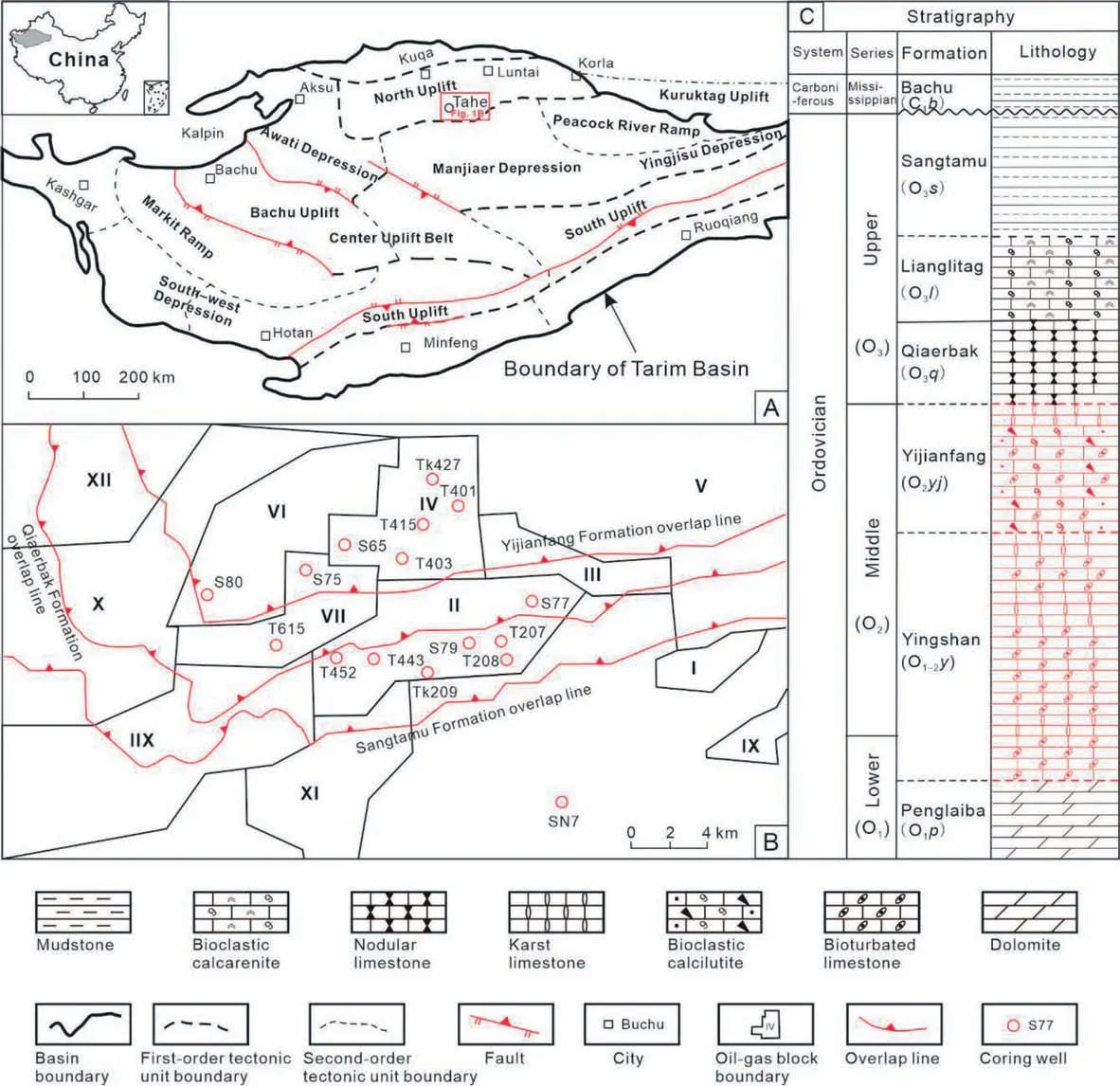
Fig.1 Geographical location,regional division and stratigraphic column of the Tahe oilfield(the study area).A)Geographical location(gray area in the inset map)and tectonic zones of the Tarim Basin.The inset map of China is modified after the Standard Map Service of the National Administration of Surveying, Mapping and Geoinformation of China (http://bzdt.ch.mnr.gov.cn/) (No. GS (2020)3185); B) Location of the observed and sampled coring wells(marked by red circles)in the 12 oil-gas blocks(I-XII)of Tahe oilfield;C)Lithostratigraphic column of the study area, with the focus strata (i.e., the Yijianfang and Yingshan formations) being painted in red color.
This paper aims to understand the alteration mechanism and effects of bioturbation on oil and gas reservoirs in the Ordovician Yingshan and Yijianfang formations of the Tahe oilfield. The petrophysical characteristics of bioturbation and host sediments in carbonate rocks, such as mineral composition, pore spaces, porosity and permeability, are studied. Moreover, the effect of bioturbation on petrophysical properties of carbonate rocks were carefully analyzed.This study can further provide reference and guidance for estimating oil and gas resources, optimizing development plan and predicting productivity of the Ordovician complex carbonate reservoirs in the Tahe Oilfield.
2.Geological settings
The Tahe oilfield is located in the northern Tarim Basin, near the boundary between Bayinguoleng Mongol Autonomous Prefecture and Aksu area, Xinjiang, China (Li, 2012; Han et al., 2013; Li et al.,2016). The Tahe oilfield is approximately 50 km to the southwest of Luntai county and 70 km to the southeast of Kuqa county (Fig. 1A), which has an area of over 2400 km2and can be divided into 12 blocks based on reservoir characteristics (Fig. 2B). It lies in the southern slope of the middle part of the North Uplift(Yan et al.,2002;Tian et al.,2016).At present,its discovered oil and gas reserves have exceeded 92.4?108bbl. The oil-bearing strata, from bottom to top, comprise the Ordovician, the Carboniferous and the Triassic,in which oil and gas reserves accumulates with the highest degree in the Ordovician carbonates,accounting for more than 90% of the total proven reserves (Chen et al., 2014).

Fig. 2 Bioturbation features on the Ordovician core slabs of the Well S77 (5548.07-5550.48 m) in the Tahe oilfield. A) A typical core slab,shows that the bioturbated zone is mostly filled with asphaltene heavy oil and is mostly dark-grey and grey-black in color (white arrows),whereas the host sediments are rarely stained with asphaltene heavy oil and is relatively light in color (yellow arrows); B) Continuous core slabs show the spatial variation and filling characteristics of the burrow-fills (white arrows) and the host sediments (yellow arrows).
Drilling shows that the Ordovician strata in the Tahe oilfield include the Lower Ordovician Penglaiba Formation, the Lower-Middle Ordovician Yingshan Formation, the Middle Ordovician Yijianfang Formation, and the Upper Ordovician Qiaerbak, Lianglitag and Sangtamu formations, totalling about 1000 m in thickness (Zhang et al., 2019). Among these strata,parallel unconformities exist between the Penglaiba Formation and the Yingshan Formation, the Yingshan Formation and the Yijianfang Formation, the Yijianfang Formation and the Qiaerbak Formation, and the Lianglitag Formation and the Sangtamu Formation respectively(Fig.1).The Sangtamu Formation and the overlying Carboniferous Bachu Formation contact with an angular unconformity (Li et al., 2016; Tian et al.,2016; Zhang et al., 2019; Jin et al., 2020). Furthermore, the Lower and Middle Ordovician rock assemblages and sedimentary sequences vary markedly from those of the Upper Ordovician (Fig. 1C), with the exception of the Upper Ordovician Sangtamu Formation,which contains more clastic rocks,the remaining formations are mainly carbonate rocks with dolomite content declining from bottom to top(Du et al.,2018;Ye et al., 2019).
Transgression and regression occurred twice during the Early Ordovician, and then continuous transgression in the Middle Ordovician (the first inundation of the carbonate platform at the end of the Middle Ordovician) and successive transgression in the Late Ordovician period (the second inundation of the carbonate platform). The depositional environment transitioned from restricted carbonate platform facies to open carbonate platform facies, and then to carbonate platform marginal facies and slope facies,subsequently, changed to restricted carbonate platform facies, and finally a large transgression occurred and the sedimentary environment was mixed shelf facies (Liu et al., 2002; Yan et al., 2002; Deng et al.,2008; Guo et al., 2018). During the Lower-Middle Ordovician (the sedimentary periods of the Yingshan and Yijianfang formations) transgression and regression,plenty of burrows were produced by organisms on the surface or within the carbonate sediments, and these burrow-fills formed a wealth of diffuse bioturbated textures whose components are dolomitemicrosparstone during the later diagenetic modification (Niu et al., 2017). It is now generally accepted that their origins can be traced back to the synergistic results of bioturbation and inhomogeneous dolomitization (Guo et al., 2016, 2020; Du et al., 2018; Wu et al.,2018).
3.Materials and methods
In total, 16 wells with Ordovician penetration,totalling 982 m in thickness from the Tahe oilfield,were selected for detailed observation and description (Fig. 1B). 127 samples (41 samples from Yijianfang Formation, and 86 Samples from Yingshan Formation, respectively) with bioturbation structure were selected to make 148 thin sections (see Table 1). These thin sections were examined to identify elemental components, mineral composition,texture and fabric by using the polarizing microscope(Zeiss Scope A1), the cathodoluminescence microscope (CITL CL8200-MK5 + Zeiss Axioscope A1) (CL),and the X-ray fluorescence analyzer (Bruker-M4 Plus AMICS) (XRF). 9 samples (4 samples from Yijianfang Formation and 5 samples from Yingshan Formation,respectively) were selected to observe microscopic pore structure and mineral features using the scanning electron microscope (Zeiss Ma15) (SEM) and the backscatter scanning electron microscopy (Sigma 300) (BSEM) at the Key Laboratory of Biogenic Traces and Sedimentary Minerals of Henan Province(Jiaozuo), National Energy Administration Key Laboratory of Co-extraction Technology of Coal and Coal-bed Methane (Jincheng), Key Laboratory of Paleomagnetic and Palaeotectonic Reconstruction,Institute of Geomechanics, Chinese Academy ofGeological Sciences and the Laboratory of Boyue Instruments (Shanghai) Co., Ltd (Table 1). The microscopic reservoir spaces in the burrow-fills and the host sediments were observed and described,respectively.
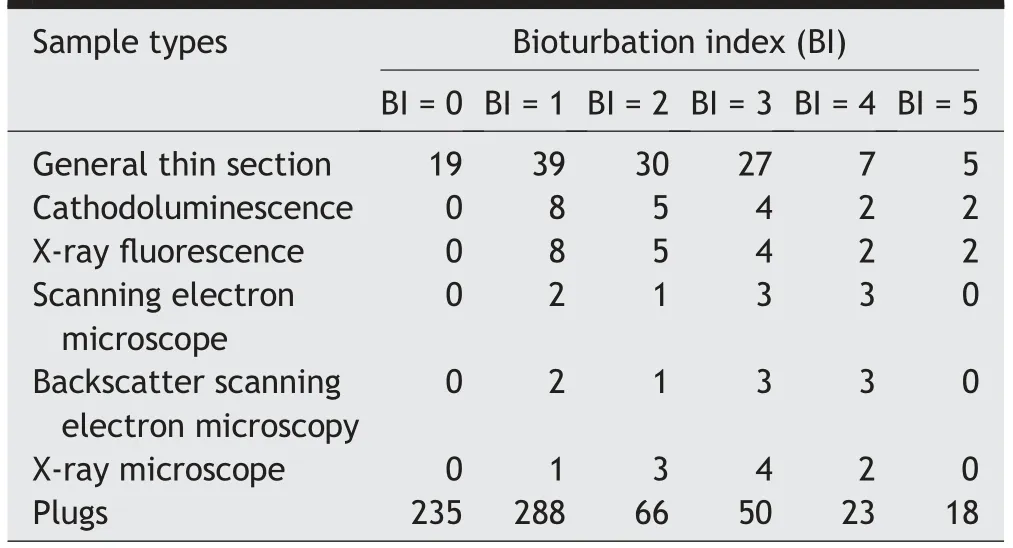
Table 1 Statistical data of the samples from Ordovician Yijianfang and Yingshan formations in the Tahe oilfield,Tarim Basin.
In order to intuitively and quantitatively analyze the pore structure characteristics of the bioturbated carbonate reservoir in the study area, 10 three dimensional (3D) scanned data volumes (i.e., 4 from Yijianfang Formation and 6 from Yingshan Formation,respectively) were obtained using the X-ray microscope (Zeiss Xradia 510 Versa) (XRM) to scan the rock plugs in the Key Laboratory of Paleomagnetic and Palaeotectonic Reconstruction, Institute of Geomechanics, Chinese Academy of Geological Sciences(Table 1). The burrow morphology and inner pore structure were reconstructed and characterized with digital core software and their connectivity was analyzed. The image segmentation of the pore and matrix was carried out by selecting the Representative Elementary Volume(REV)through the slice analysis of the obtained 3D data volume, and then the 3D pore structure raster model of the analyzed samples was obtained through the 3D reconstruction of the image segmented slice. Finally, the reconstructed 3D pore structure raster model was extracted and a ball-andstick model was built to quantitatively characterize the pore structure of the biogenically-enhanced carbonate reservoirs.
445 plugs (i.e., 131 plugs from the Yijianfang Formation and 314 plugs from the Yingshan Formation, respectively) (3-5 cm in length, 2.5 cm in diameter)bearing burrow-fills and 235 plugs(i.e.,74 plugs from Yijianfang Formation and 161 plugs from the Yingshan Formation, respectively) containing the host sediments were collected (Table 1) and classified according to the bioturbation grade classification scheme recommended by Knaust (2012), and porosity and permeability were measured by means of a porosity and permeability analyser (CMS-300) at the Research Institute of Petroleum Exploration &Development of the Sinopec Northwest Bureau according to the industry standard of “Determination of porosity and permeability of rock under overburden pressure” of the People's Republic of China(SY/T 6385-2016). The precisions of the measurements of volume, porosity and permeability were±0.03 cm3, ±0.2% and ±0.03?10-3μm2, respectively.The relationship between bioturbation intensity and reservoir properties (porosity and permeability) and the effect of bioturbation on mineral composition,pore structure and rock properties have been analyzed.
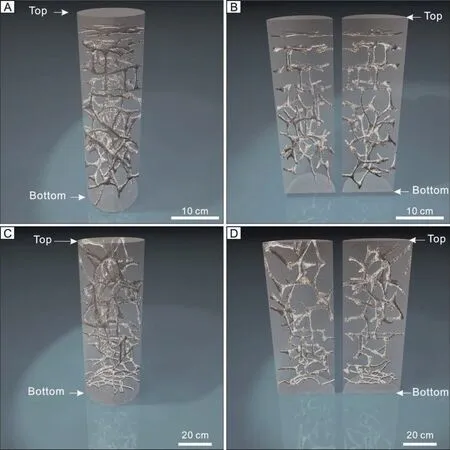
Fig. 3 The three-dimensional (3D) conceptual model of the burrow morphology in the Ordovician cores from the Tahe oilfield. A) 3D conceptual model of the burrows in the whole core of the Well T208 (5584.45-5584.82 m); B) 3D conceptual model of the burrows on the sectioned core of the Well T208 (5584.45-5584.82 m). From bottom to top, the burrows present from Thalassinoides-like boxworks via Thalassinoides-like networks to Planolites-like horizontally-intersecting burrows;C)3D conceptual model of the burrows in the whole core of the Well S77(5549.94-5550.29 m);D)3D conceptual model of the burrows in a sectioned core of the Well S77(5549.94-5550.29 m).From the bottom to top,the burrows present from Planolites-like horizontally-intersecting burrows via Thalassinoides-like networks to Thalassinoideslike boxworks.
4.Results
4.1. Morphological characteristics of bioturbation
Bioturbation in the carbonate reservoirs of the Tahe oilfield is mainly distributed in the Lower-Middle Ordovician Yingshan Formation and the Middle Ordovician Yijianfang Formation(Fig.1C).The bioturbated areas in the core slabs show reticulated, rounded,oval, mottled or ribbon-like morphology (Fig. 2). Two types of bioturbation, Thalassinoides-like and Planolites-like, were identified based on the morphological characteristics,i.e.,swelling in the T-junction.Thalassinoides-like burrows dominate in the bioturbated limestone.Based on detailed core records,a wealth of core slabs and the spatial morphological characteristics of the burrow-fills presented by 3D Xray microscopy,a three-dimensional conceptual model of the burrow-fills in the cores has been established using 3D modelling software (Fig. 3). Two types of variation in the spatial morphology of the burrows were identified: (1) From the bottom to top in some parts of the cores, the burrows show from threedimensional boxworks via two-dimensional networks to Planolites-like horizontal burrows;(2)In other parts of the cores,the burrows present from Planolites-like horizontal burrows via two-dimensional networks to three-dimensional boxworks from bottom to top.

Fig. 4 Microphotographs of the Ordovician bioturbation in the Tahe oilfield. A) Scanning thin section of bioturbated zone (mainly Thalassinoides-like burrow)in Well S77 (5578.93 m);B) A local enlargement of A. The lower part is burrow-fills filled with dolomite crystals and displays many intergranular pores (a part of Thalassinoides-like burrow); while the upper part are host sediments which are mainly microcrystalline calcite; C) Cathodoluminescence microphotograph of B; D) A local magnification of the intermediate burrow-fills in A; E)Cathodoluminescence microphotograph of D.
In addition,the bioturbated areas are mostly filled with asphaltene heavy oil and occur as dark-grey and grey-black in color, whereas the host sediments are rarely stained by asphaltene heavy oil and are relatively light in color. Micro-fractures or stylolite at the boundary of the bioturbated zone are common, and the interior of the microfractures or stylolite are also mostly filled with bitumen, resulting in a large difference in color between the burrow-fills and host sediments (Fig. 2). The bioturbation zone filled by asphaltene heavy oil indicates that the pores are more developed in the burrow-fills than those in the host sediments.
4.2. Composition characteristics of burrowfills and host sediments
The burrow-fills are mainly composed of dolomite,whose crystal shapes are subhedral-euhedral, seldom anhedral (Fig. 4). Sometimes, residual micrite is common between the dolomite crystals. The sizes of dolomite crystals are generally no more than 200 μm,ranging between 100 μm and 200 μm.The burrow-fills are generally of fine-crystal texture, seldom microcrystalline (Fig. 4). Under cathodoluminescence microscope, the burrow-fills display a brownish red or bright-red luminescence (Fig. 4C, E), and present obvious clear rim and cloudy center. These dolomite crystals were mainly formed by dolomitization during the later deep burial process. At times, clearly identifiable dark haloes (Fig. 4A) are visible between the burrow-fills and host sediments. It is presumed as the boundaries stained by asphaltene heavy oil.Under the polarizing microscope and cathodoluminescence microscope, the host sediments show mostly microcrystalline structure and display no luminescence or extremely weak luminescence with discrete intervening bright blue spots. It means that their mineral composition is mainly microcrystalline calcite bearing small amounts of potassium feldspar(possibly residual part of the altered clay minerals)(Fig.4C).The results of XRF analysis show that the burrow-fills are enriched in Mg element and the host sediments are enriched in Ca element. It indicated that the burrow-fills are dolomite and the host sediments are predominantly calcite (Fig. 5). The dolomite intergranular pores within the burrow-fills are well developed and are the main pore spaces of the kind of reservoirs,whereas the pore spaces are poorly developed in the host sediments.
Under SEM and BSEM, the dolomite grains and their intergranular pores are well developed within the burrow-fills (Fig. 6A and B). The dolomite crystals are subhedral-euhedral. Under BSEM, the subhedral-euhedral rhombic dolomite crystal shapes are more obvious, and dissolved micro-pores are seen in the crystals, and embayment-like dissolution features are seen at the boundary of local intergranular pores (Fig. 6B). The mineral composition of the host sediments is mainly calcite, and the lithology is very dense and the pores are poorly developed(Fig. 6C and D).
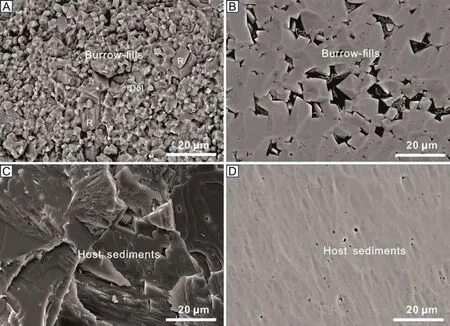
Fig. 6 SEM and BSEM images of a bioturbation-bearing sample from the Ordovician Yijianfang Formation, Well SN7 (6487.13 m) in the Tahe oilfield.A)The burrow-fills are dolomite crystals(Dol)with many intergranular pores,as well as residual clay carbonate minerals(R)among the dolomite crystals; B) BSEM image of the same sample as A; C) SEM image of the host sediments, showing that the host sediments are mainly calcite and pores are not developed; D) BSEM image of the same sample as C.
4.3. Porosity and permeability of burrow-fills and the host sediments
The statistical results of the porosity and permeability of the plugs show that the porosity ranges from 0.1% to 1.2% with a mean value of 0.582%, and the permeability ranges from 0.001?10-3μm2to 0.03?10-3μm2with a mean value of 0.005?10-3μm2when BI=0(unbioturbated limestone) (Table 2). With theincreasing bioturbation index, porosity firstly increased then decreased, with a relatively narrow variation between 0.1% and 10.8% (Table 2; Fig. 7A),whereas the permeability varied from 0.001?10-3μm2to 48.1?10-3μm2, increasing over 4.8?104times(Table 2; Fig. 7B).

Table 2 Statistical results of porosity and permeability of the Ordovician bioturbation-bearing plugs with different bioturbation index from the Ordovician of the Tahe oilfield.
By analyzing the extraction results of pores in the REV (Fig. 8), we found that the volume of pores concentrating in 10-100 μm3accounted for nearly 67% of the total number of pores, and the number of surface areas of pores in 10-100 μm2accounted for approximately 59% of the total number of pores.About 91%of the total number of throat channels has the radius from 0 to 40 μm. The equivalent radius of throats is mostly between 0 and 10 μm,accounting for 84%of the total number of throats.The distribution of pore and throat equivalent radius shows the characteristics of skewed distribution, with the main equivalent radius ranging mostly between 0 and 4 μm,among which the equivalent radius of pores is most between 0 and 2 μm, while the equivalent radius of throats is most between 2 μm and 4 μm. Pores and throats are dominated by micropores and microfractures (Fig. 9). In addition, the pore network model reveals that the porosity of the burrow-fills is between 7% and 10%, which is much higher than the porosity value of the core plug due to two reasons.The first reason is that the measured porosity value of the plug is a combined effect of burrow-fills and host sediments, while the porosity of pore network model is mainly dominated by burrow-fills. The second reason is that the burrow-fills contains a large number of isolated pores, which cannot be detected during the plug porosity measuring because fluids cannot be injected, however, these isolated pores can be extracted and calculated volume in the pore network model. Both of them are good indicators that bioturbation enhances reservoir petrophysical properties.The number of isolated pores is relatively large,whereas the volume of connected pores is relatively large in the total pore volume. The topology of connected pores is very complex, and the pore connectivity is very well. Our previous REV coarsening and upgrading analysis also indicated that the pores in this kind of carbonate reservoir with bioturbations are locally well connected,but the overall connectivity is relatively poor (Niu et al., 2020b).
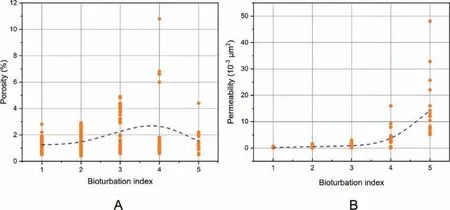
Fig. 7 Cross-plot of porosity, permeability and bioturbation index(BI) of the 445 plugs from the Ordovician of the Tahe oilfield. A) Porosity value presents as a first slowly increasing and then decreasing trend with BI increasing;B)Permeability value presents a gradually increasing trend with BI increasing.
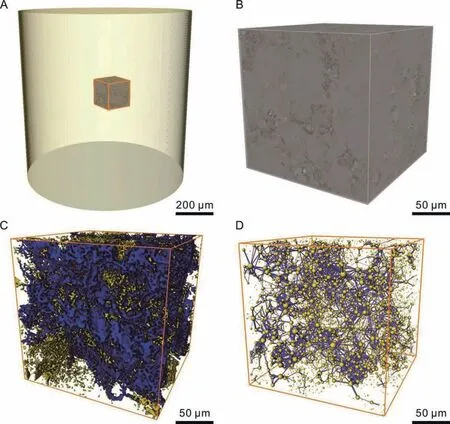
Fig.8 Representative Elementary Volume(REV)and pore network model for the Ordovician digital core of the selected plug from Well S77(5567.03 m) in the Tahe oilfield. A) Selection of REV in the scanned 3D data volume; B) Grey-scale model of REV; C) 3D raster model of the pore structure(connected pores in blue vs.unconnected pores in yellow);D)Ball-and-stick model of the pore network structure,with pores in yellow, and node-to-node branches in blue, which means that the pores are connected.
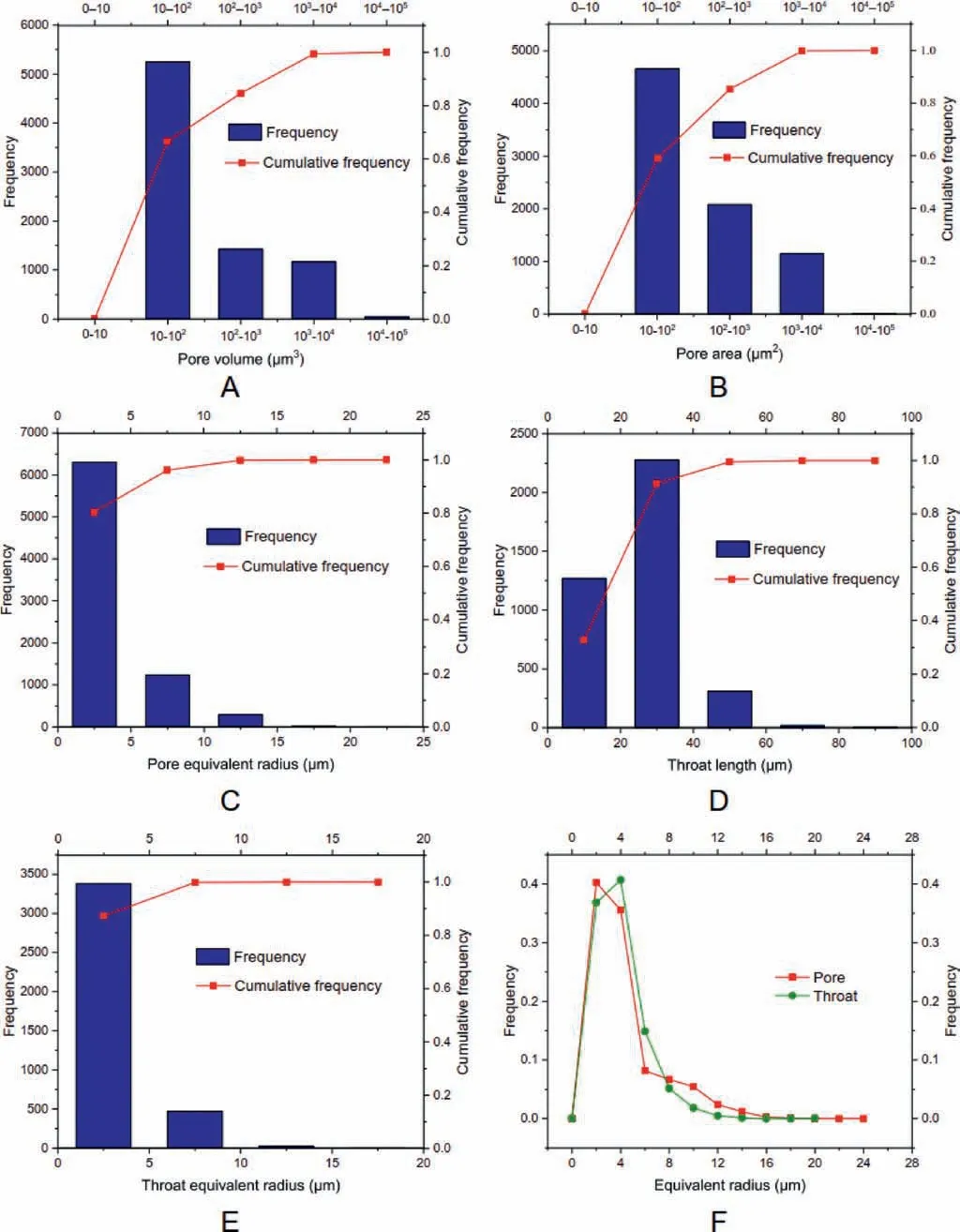
Fig.9 Histograms and line graph of pores and throats of selected Ordovician typical samples from Well S77(5567.03 m)in the Tahe oilfield.A)Pore volume frequency histogram;and the cumulative frequency of the number of pores shows a rapid increase from 0 to 66.5%then by a gradual increase;B) Pore area frequency histogram; and the cumulative frequency of the number of pores shows a rapid increase from 0 to 59.0%then by a gradual increase;C)Pore equivalent radius frequency histogram;and cumulative frequency of the number of pores shows a gradual increase slowly from 80.4%to 100%;D)The length of throats frequency histogram;and the length of throats cumulative frequency of the number of pores shows a rapid increase from 32.7% to 91.5% then by a gradual increase to 100%; E) Throat equivalent radius frequency histogram; and the cumulative frequency of the number of pores shows a rapid increase from 0 to 87.3% then by a gradual increase slowly from 87.3%to 100%;F)Pore and throat frequency folded line graph;the lines present a left-leaning feature,suggesting that pores and throats are dominated by micropores with equivalent radius from 0 to 6 μm and microfractures with equivalent radius from 0 to 4 μm,respectively.
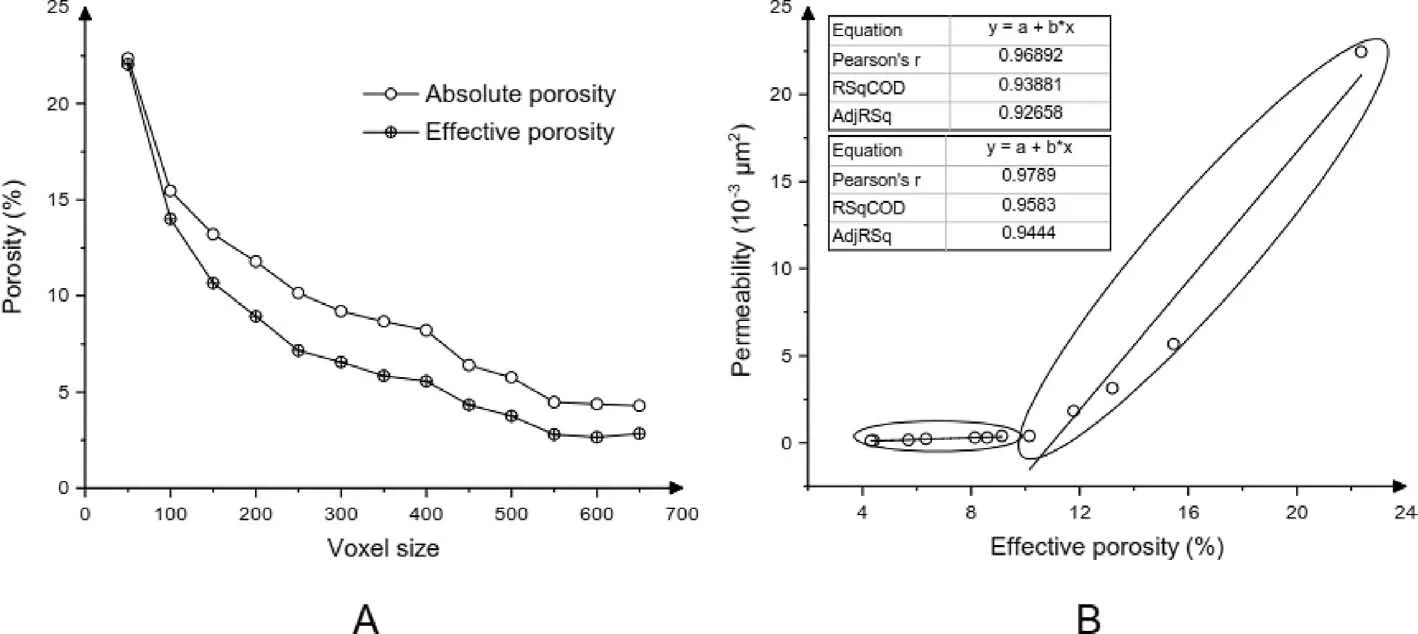
Fig. 10 Cross-plot of porosity and permeability for different sized REV in the Ordovician digital core from Well S80 (5713.9 m) in the Tahe oilfield.A)Cross-plot of effective porosity,absolute porosity and side lengths of the REV;B)Cross-plot of effective porosity and permeability,the rightmost REV has a side length of 50 voxels and the side length of the REV increased by 50 voxels from the right to the left.
In order to further analyze the effect of bioturbation on porosity and permeability and assess the relationship between porosity and permeability, 12 REVs with side lengths of 50, 100, 150, 200, 250, 300, 350, 400, 450,500,550 and 600 voxels were also selected.A REV was selected as burrow-fills at the beginning, and with the volume of REV increasing,the proportion of the selected host sediments also increases, and then the effective porosity,absolute porosity and permeability of each REV were analyzed.The results of the statistical data show that porosity decreases with increasing REV size,with a clear downward trend in effectiveand absolute porosity,eventually converging to a stable value (Fig. 10A). For side lengths from 50 to 250 voxels of the REV,the higher porosity and the higher permeability show a positive linear.However,as the REV size increases(side lengths>300 voxels), the permeability does not change dramatically even though the porosity continues to decrease(Fig.10B).
The pore structure analysis and numerical simulation of fluid percolation within REV show that the pore structures and fluid flow pathways within the bioturbated areas are very complex (Fig. 11). The simulated flow pathways reveal that the burrow-fills have relatively good pore connectivity, while the fluid flow pathways are absent in the host sediments because of the poor pores and connectivity.
5.Discussion
5.1. Bioturbation, diagenesis and petrophysical characteristics
Bioturbation and diagenesis have modified the rock fabric, pore structure and physical parameters of the carbonates (Figs. 2, 4-10), thus affecting reservoir quality and fluid flow characteristics (Fig. 11). The burrow-fills in the Ordovician Yingshan and Yijianfang formations consist of dolomites.The dolomite crystals are mainly subhedral and euhedral, presenting embayment-like dissolution features under SEM.Anhedral dolomite crystals are less common. These features indicate that these dolomite crystals were formed during dolomitization and there is ample space for recrystallization.In addition,the pore spaces have been modified during the oil-gas charging and dissolution diagenetic process (Chen et al., 2020). Therefore, the dolomite intergranular pores were well developed in the burrow-fills (Figs. 4, 6A, B) and are predominantly micropores with good local connectivity (Figs. 8 and 9) and relatively poor overall connectivity. The pores in the host sediments are not well developed (Figs. 4, 6C, D) and are poorly connected(Fig.6C and D),resulting in very low values of porosity and permeability (Table 2). The bioturbated areas in the cores are mostly filled with asphaltene heavy oil and are mostly dark-grey and grey-black in color,whereas the host sediments are rarely stained by asphaltene heavy oil and presented relatively light in color(Fig.2).So,it is believed that the pores are more developed in the burrow-fills than in the host sediments.With the increasing bioturbation intensity,the values of porosity firstly increase and then decrease(Fig.7A),whereas the values of permeability gradually increase (Fig. 7B). Moreover, the complex burrow morphology and pore structure caused the fluid flow pathways to become complex (Fig. 11).
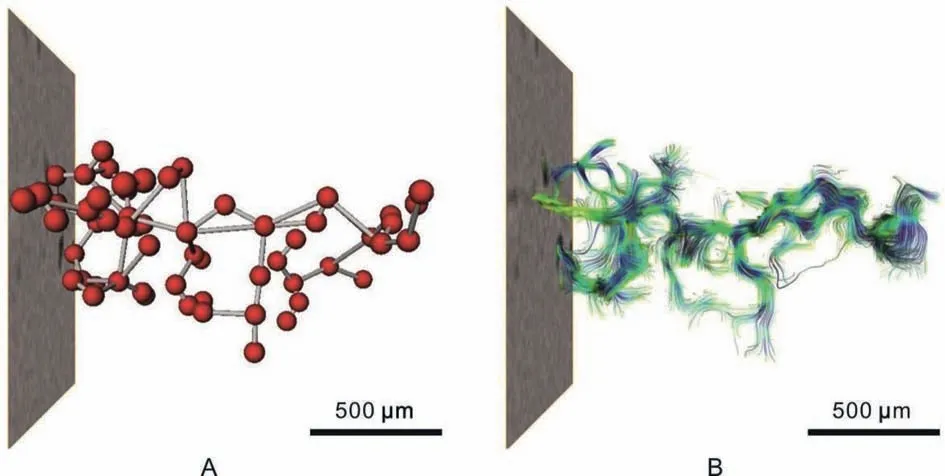
Fig. 11 Pore network model and single-phase percolation simulation diagram of a typical bioturbation-bearing REV from the Ordovician carbonate rocks in Well S80(5713.9 m),Tahe oilfield.A)The pore network model reveals that pores in the burrow-fills are well developed and have a good connectivity; B)The single-phase percolation simulation diagram reveals that the fluid flow pathways mainly along the burrowfills.
Combined with multiple factors analysis,it may be suggested that dolomitization and deep burial dissolution have a significant impact on the rock fabric and petrophysical properties of the bioturbated horizons in the Ordovician carbonates of the Tahe oilfield(Figs.6,7 and 10), resulting in a large wealth of dolomite intergranular micropores (Figs. 6, 9) and higher porosity and permeability in the burrow-fills (Fig. 7).Although previous research works have shown that the dolomitization genesis of the Ordovician carbonates in the study area may be characterized by multiple types, with different genesis and diagenetic phases(Chen et al., 2003; Zhang et al., 2010; Guo et al.,2016, 2020; Chen and Qian, 2017; Du et al., 2018; Ye et al., 2019), however, selective dolomitization induced by burrows is typical in the Yingshan and Yijianfang formations. During the diagenesis, the burrows are the dominant transport pathways for dolomitized fluids, and they can have an important influence on dolomitization during both syngenetic and quasi-syngenetic stages, as well as during burial diagenesis process.
The effect of selective dolomitization induced by burrows on rock properties(increasing and decreasing the porosity and permeability)is closely related to the dolomitization occurred in different environments(Figs. 7, 12) (Warren 2000; Zhang et al., 2010). When the Ordovician sediments of Tahe oilfield developed in the near-surface environments, near-surface burrowmediated dolomitization might occur because concentrated seawater from the supratidal evaporative environment and a mixture of seawater and atmospheric water formed, these fluids causing dolomitization occurred in an open diagenetic environment (syngenetic and quasi-syngenetic diagenetic environments)during the dolomitization process,with a large supply of external CO32-during the dolomitization process(Warren 2000;Rameil,2008).Due to the high porosity of the primary strata at this stage, the reduction in porosity is limited and some of the primary pores can still be retained, thus this dolomitization has little effect on the primary rock properties.However, the moderately saline seawater formed in the intertidal caused reflux dolomitization in a shallow burial environment, where a semi-open system of diagenesis with a relatively limited supply of external CO32-is presented (Wierzbicki et al., 2006; Rameil,2008; Niu et al., 2010), and dolomitization may induce the changes in pore types from intergranular to intercrystalline pores(Zhang et al.,2010).Dolomite is more resistant to compaction and compressional solution,therefore,more conducive to the preservation of the pores than the same level of limestone.

Fig.12 Vertical variation of the bioturbation and sea-level change curve of the Yingshan and Yijianfang formations in the Tahe oilfield.The bioturbation types and bioturbation index changed vertically showing a clear cyclical pattern(C1-C5),which is correlated with the sea-level change.
When the Ordovician sediments of Tahe oilfield developed in burial environments,with the increasing of burial depth, euhedral and subhedral dolomite would be continuously replaced by dolomitization fluids.Then the crystal morphology might be changed.Dolomites with mosaic texture were formed during the replacement with deeper burial depth. The dolomitization fluids came from two resources.Firstly,ancient sea water still stayed in rocks,and then it acted as the dolomitization fluids.Secondly,solution was formed by the mixing of groundwater and Mg2+which came from the process of stabilization of former formed high-Mg mineral (high-Mg calcite and initially formed aragonite).Migration pathways of dolomitization fluid were still burrows which owned better porosity and permeability due to the diagenetic modification.
In addition, the bioturbated carbonates of the Ordovician Yingshan and Yijianfang formations in the Tahe oilfield are both buried below 5400 m in depth.In such a deep burial condition, dolomite is more susceptible to dissolute than limestone with the temperature-pressure effect (Yang et al., 1995; Zhu et al., 2007; Chen and Qian, 2017). Therefore, under the deep burial conditions,the burrow-fills can also be dissolved to form beneficial pore spaces (Ruan et al.,2013; Valencia and Laya, 2020). Although the relationship between dolomitization and permeability has been relatively rarely studied,it is generally accepted that dolomitization can significantly increase permeability, even if it does not significantly increase the porosity of the reservoir (Fig. 7). This is because the dolomite formed after dolomitization has much more intercrystalline pores (which are most evident at the quasi-syngenetic dolomitization stage). If these intercrystalline pores are connected, they may have a higher permeability. The increased permeability in turn influences the pattern and process of dolomitization.
Thus, for the bioturbated area in the Ordovician carbonates of the Tahe oilfield, early dolomitization(mainly at the shallow burial stage)was very favorable for developing pores, and dolomitization at this stage allows some primary pores to be inherited and adjusted, which is more conducive to pore preservation. The late stage (middle-deep burial stage) dolomite recrystallization and excessive dolomitization may have a negative impact on the reservoir petrophysical properties, which may explain that porosity value firstly increases and then decreases with the increasing intensity of bioturbation. However, this negative impact is very limited in scope in terms of the degree of dolomitization of the burrow-fills in the study area, and has been confirmed by detailed statistical characteristics of porosity and permeability(Fig. 7; Table 2). If dolomitization is the basis for the development of pore spaces in the bioturbated carbonate rocks of the Ordovician Yingshan and Yijianfang formations in the Tahe oilfield,the dissolution is key to form effective pore spaces,especially the atmospheric freshwater dissolution associated with (high-frequency) stratigraphic interfaces or tectonic unconformities plays a significant role for the development of biogenically enhanced carbonate reservoirs in the study area.In addition,in deeply buried bioturbated limestone(more than 5400 m in depth),a large wealth of dissolved pores developed in the burrow-fills are also important sources of those effective pore spaces. The pores in the burrow-fills acted as the transport channel for diagenetic fluids or hydrocarbons during hydrocarbon generation, presenting the burrow-fills stained by asphaltene heavy oil(Fig. 2). In summary, the diagenetic modifications of selective dolomitization and dissolution induced by organisms burrowing in the multiple diagenetic settings provide excellent external conditions and propulsion for enhancing petrophysical properties of the Ordovician bioturbated carbonate reservoirs in the Tahe oilfield.
5.2. Sedimentary facies and bioturbation
The Ordovician strata in the Tahe oilfield formed in a restricted to an open carbonate platform facies, of which the Yingshan and Yijianfang formations were mainly deposited in supratidal and intertidal environments (Liu et al., 2002; Deng et al., 2008), but the southern margin of the Tahe oilfield was a slope zone(e.g.,the Upper Ordovician Sangtamu Formation).The Ordovician in the study area experienced several tectonic modifications during Hercynian, Indo-Chinese and Himalayan tectonic movements (Tian et al.,2016; Du et al., 2018), and the northern part of the study area was uplifted and the strata were denuded(Fig. 1B) (Chen et al., 2014). Nowadays, only part of the Yingshan Formation and the underlying strata have been remained in the northern part of the Tahe oilfield(blocks IV, V, and VI), and the strata development are gradually complete(blocks II,III,VII,VIII,and IX)with increase in thickness towards the south (Jin et al.,2020).
Two types of bioturbation, Thalassinoides-like burrows and Planolites-like burrows, have been identified in the Ordovician cores of the Tahe oilfield.Thalassinoides-like network burrows are mainly represented by the horizontal interconnected burrows,while Thalassinoides-like boxwork burrows mainly consist of vertical shafts to connect to the sediment interface and formed a 3D maze gallery. They often present Y-shaped or subvertical branches, and have obvious swellings in T-junctions. It is generally accepted that Thalassinoides is dwelling and feeding burrows for crustaceans (decapod shrimp or shrimplike), however, the tracemaker of the Ordovician Thalassinoides burrow is unknown. It often occurs in intertidal environments in the Lower Paleozoic strata as a common trace fossil (Buatois et al.,2002; Ekdale and Bromley, 2003; Sharafi et al., 2012). Less Planolites-like burrows are distributed in the study area and are only observed in some well cores (e.g.,Well T208).
The variation in the morphology and size of the burrows can well reveal the deposition rate of host sediments, rate of bioturbation, and local sea-level change in the depositional environment. The variations of morphology and bioturbation types in the Ordovician Yingshan and Yijianfang formations in the Tahe oilfield show a clear cyclical pattern(Guo et al.,2018),which is correlated with the sea-level change in the study area (Fig. 12). In general, there are two patterns of variation in the spatial morphology of the burrows: (1) From bottom to top in some well cores(e.g., Well S80), the burrows present from 3D boxworks via 2D networks to Planolites-like horizontal burrows.Sedimentological and ichnological analysis of the first pattern suggests that the burrow sequences formed during transgression.(2)From bottom to top in other well cores(e.g.,Well S77),the burrows present from Planolites-like horizontal burrows via 2D networks to 3D boxworks. Sedimentological and ichnological analysis of the second pattern suggests that the burrow sequences formed during the regression(Fig. 12). The quantity of Thalassinoides-like burrows is larger than that of Planolites-like burrows in the Yingshan and Yijianfang formations, representing a greatly bioturbated thickness during the regression.In summary, with suitable sedimentary environments,ecological conditions, favorable spatiotemporal sediment matching, and abundant organism-substrate interaction, multiple burrows in the Ordovician Yingshan and Yijianfang formations had overprinted to form a large-scale bioturbated carbonate rocks with lateral continuity and vertical connectivity,which has provided a solid material foundation for the formation of biogenically enhanced porosity and permeability in carbonate reservoirs of the study area.
Bioturbation alters the Ordovician petrophysical properties to improve the porosity and permeability of the strata, which is helpful for forming potential reservoir spaces. As in the study area, the effective carbonate reservoirs formed by bioturbation are mainly developed in the Paleozoic strata. In China,these kinds of carbonate reservoirs are well developed in the Ordovician Majiagou Formation in the Ordos and North China basins (Fei and Zhang, 2002; Chen et al.,2011; Niu et al., 2020a). In other countries, these kinds of carbonate reservoirs are exemplified by the Ordovician Red River Formation in Saskatchewan and Manitoba, Canada (Gingras et al., 2004b), the Upper Devonian Wabamun Group, central Alberta, Canada(Baniak et al., 2013), the Late Ordovician Bighorn Dolomite in Wyoming (Zenger, 1996), the Ordovician Yeoman Formation in the Williston Basin of North America(Pak and Pemberton,2003),and the Devonian Lonely Bay Formation in Canada's Northwest Territories(Corlett and Jones,2012).As mentioned above,the presence of fabric-selective dolomite in association with trace fossils is attributed to chemical and physical alteration of the substrate by burrowing organisms. It is also noted that it is most likely that physical and chemical factors together determine the resulting fabric in burrow-mottled limestone (Gingras et al.,2004b).
Identifying and characterizing bioturbation within a sedimentary unit is important, but further data are needed to verify their impact on fluid flow (Golab et al., 2017a, b). Meanwhile, understanding the effects of bioturbation-influenced porosity and permeability on fluid pathways is vital for creating a geologic and hydrocarbon-bearing stratigraphic framework for the bioturbated Carbonate reservoir.The implications of this type of studies are far reaching, particularly pertaining to calculations of reserves and their deliverability (Pemberton and Gingras, 2005). The carbonate rocks of the Ordovician Yingshan and Yijianfang formations from the Tahe oilfield provide an analogue for bioturbated reservoirs with low permeability in the Paleozoic basins around the world.
6.Conclusions
(1) Thalassinoides-like burrows and Planolites-like burrows mainly occur in the Ordovician cores of the Tahe oilfield, ranging from the Lower-Middle Ordovician Yingshan Formation to the Middle Ordovician Yijianfang Formation.Two patterns of variation in the spatial morphology of the burrows are identified. The fist pattern, from bottom to top, displays that the burrows range from 3D boxworks via 2D networks to Planolites-like horizontal burrows.Sedimentological and ichnological analysis of the first pattern suggests that the burrow sequences formed during transgression. The second pattern, from bottom to top, shows that the burrows range from Planolites-like horizontal burrows via 2D networks to 3D boxworks.Sedimentological and ichnological analysis of the second pattern suggests that the burrow sequences formed during regression.
(2) The pores are poorly developed in the host sediments and thus are incapable of forming effective reservoir spaces. However, welldeveloped intercrystalline pores among dolomites and microfractures in bioturbated sediments with better connectivity can form effective reservoir spaces.With the increase of bioturbation intensity, the porosity of the bioturbated sediments firstly increased and then decreased, but the permeability increased all the time.
(3) Favorable sedimentary environment and suitable ecological conditions result in the formation of a large wealth of bioturbations.Subsequently, diagenesis (particularly dolomitization and dissolution) has played a positive role in altering the rock fabric and improving the petrophysical properties of bioturbated sediments.This study can be used as a tool and guide for explaining the key control factors and constraints influencing the production of bioturbation, assessing oil and gas supplies,choosing an optimal development strategy,forecasting productivity, and enhancing oil recovery in diverse reservoirs such as the Ordovician carbonate reservoirs in the Tahe oilfield.
Abbreviations
BSEM Backscatter scanning electron microscopy
CLCathodoluminescence microscope
ESEM Environment scanning electron microscope
REVRepresentative Elementary Volume
SEMscanning electron microscope.
XRFX-ray fluorescence analyzer.
XRMX-ray microscope.
BIBioturbation index
Funding
1) Project supported by the National Natural Science Foundation of China (Grants No. 41472104 to YBN). The property characterization and interpretation of controlling factor and restriction mechanism of those ichnofabrics enhanced reservoir capacity in marine carbonate rocks.
2) Project supported by National Natural Science Foundation of China (Grants No. 41102076 to YBN).Ichnofabrics and their reservoir modification effecs in the carbonate rocks from the Ordovician Majiagou Formation, Northwest Henan Province, China.
3)Project supported by Natural Science Foundation of Henan Province, China (Grants Nos. 202300410185 to YBN, and 212300410349 to LJZ).
4) Project supported by The Science and Technology Major Project of Shanxi Province,China(Grant No.20181101013-1), the Program for Innovative Research Team (in Science and Technology) in Universities of Henan Province,China(Grant No.21IRTSTHN007),and the Program for Innovative Research Team (in Science and Technology) of Henan Polytechnic University(Grants Nos. T2022-5 and T2020-4).
5) The Funddamental Research Funds for the Universities of Henan Province (Grant No. NSFRF200340 to LJZ).
Availability of data and materials
All data and materials generated or used during the study appear in the article.
Authors' contributions
YBN conceived and designed the study and wrote the manuscript.MYC performed the data analyses and manuscript preparation. LJZ performed the data analyses and wrote the manuscript. JHZ helped perform the analysis with constructive discussions. SXL, DW,and ZLX performed the experiment. PJW helped perform the analysis with helpful discussion. All authors read and approved the manuscript.
Competing interests
The authors declare that they have no competing interests.
Acknowledgements
We thank the two anonymous reviewers for their useful comments.We are grateful to Dr.Zhen-Feng Yu(National Energy Administration Key Laboratory of Coextraction Technology of Coal and Coal-bed Methane)for technical advice on observing and capturing SEM and ESEM Photomicrographs.Dr.Xin-Bian Lu(Research Institute of Petroleum Exploration & Development of the Sinopec Northwest Bureau) and Dr. Li Wei(Research Institute of Petroleum Exploration & Development of PetroChina Southwest Oil & Gas Field Company) who provided guidance and helped with measuring and collecting porosity and permeability data. Finally, we thank Jian-Guo Sun for thin-section preparation.
 Journal of Palaeogeography2022年1期
Journal of Palaeogeography2022年1期
- Journal of Palaeogeography的其它文章
- Giant ooids of microbial origin from the Zhangxia Formation (Cambrian Miaolingian Series) in North China
- Book Review on River Planet:Rivers from Deep Time to the Modern Crisis by Martin Gibling
- Palaeoenvironmental reconstruction for the Permian (lower Gondwana) succession of the Godavari Valley Coalfield in southern India based on a combined palynofacies, carbon isotope, and biomarker study
- Lagoonal carbonate deposition preceding rifting-related uplift: evidence from the Bartonian-Priabonian (Eocene) of the northwestern Gulf of Suez (Egypt)
- Middle Jurassic climate oscillations from paleosol records of the Sichuan Basin,SW China
- Silurian ostracods from the Nyalam region,southern Tibet,China and their implications on palaeoenvironment and palaeobiogeography
